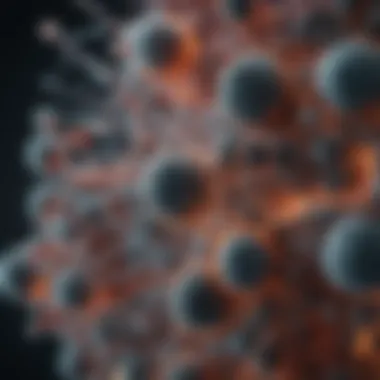Exploring Super Resolution Microscopy Advances


Intro
Super resolution microscopy is now a keystone in the field of biological imaging. This advanced technology enables researchers to observe cellular structures and processes with a clarity that was once deemed impossible. Unlike traditional microscopy methods, which are limited by the diffraction of light, super resolution techniques break through these constraints. They provide insights into cellular dynamics and interactions at a molecular level. As the field progresses, understanding these advancements and their implications for biological research becomes crucial.
In this article, we will assess recent developments in super resolution microscopy. We will explore how these innovations are reshaping our understanding of complex biological systems. The narrative will delve into various methodologies, emphasizing their practical applications in modern research.
Moreover, we will highlight the challenges that come with such groundbreaking technology. Addressing these issues will help us appreciate the future directions for super resolution microscopy. As this field evolves, so does its impact on our grasp of cellular processes and disease mechanisms.
With this context in mind, let's examine the most recent advances in super resolution microscopy.
Foreword to Super Resolution Microscopy
Super resolution microscopy signifies a pivotal advancement in the realm of imaging biological samples. Its significance lies in the unparalleled clarity and precision it offers when visualizing cellular and subcellular structures. As the need for detailed imaging intensifies within both academic and medical research, the emergence of super resolution techniques has become critical. These techniques extend our capacity to discern structures that were once thought hidden beneath the diffraction limit of conventional light microscopy.
Definition and Importance
Super resolution microscopy encompasses various techniques designed to capture images at resolutions beyond the diffraction limit imposed by light. This surpassing of traditional boundaries enables researchers to observe finer details in the architecture of cells, thereby providing insights into complex biological processes that were previously unobservable.
The importance of super resolution microscopy extends into multiple facets of research. In a practical manner, it not only enhances our fundamental understanding of biological phenomena but also paves the way for advancements in disease diagnosis and treatment. For example, the ability to visualize protein localization and dynamics with high precision transforms how we perceive cellular functions and interplays.
Historical Context
The roots of super resolution microscopy trace back to the early 2000s, when researchers began to push the boundaries of optical limitations. Techniques such as stimulated emission depletion (STED) and structured illumination microscopy (SIM) emerged from the investigative endeavors aimed at enhancing resolution. These methods challenged established norms in microscopy by proposing innovative approaches to generate detailed images, thereby revolutionizing how scientists study life at the microscopic level.
Initially, super resolution microscopy faced skepticism regarding its practicality and reliability. However, as experimentation and development progressed, recognition of its potential established a firm foothold in the scientific community. Today, it stands as a cornerstone technique in cellular biology, with researchers employing it to explore the intricacies of life with unprecedented detail.
"Super resolution microscopy allows us to visualize the previously invisible details of biological systems, marking a transformative step in biological research"
The evolution of super resolution microscopy has not only led to richer data but has also fostered interdisciplinary collaboration across fields like biochemistry, neurology, and cancer research. As this technology continues to develop, it opens new avenues for research, pushing the limits of our understanding of biological systems.
Fundamentals of Microscopy Resolution
Understanding the fundamentals of microscopy resolution is crucial for grasping the advancements presented by super resolution techniques. Resolution refers to the ability of a microscope to distinguish between two close points. The importance of advancing resolution techniques lies in the capacity to resolve structures that are smaller and more intricate than ever before, allowing scientists to delve deeper into cellular processes and mechanisms.
Concept of Resolution
Resolution defines the clarity of an image produced by a microscope. It is typically measured in terms of distance between two points that can be distinctly identified. In practical terms, better resolution means clearer images that reveal more detail about the structure being observed. For instance, high resolution enables the study of subcellular components, which is vital for understanding how these components interact and function within the cell.
In microscopy, resolution is influenced by several factors, including optical quality, wavelength of light, and the numerical aperture of the objective lens. The relationship between these factors illustrates why enhancing resolution remains a core focus in microscopy research. Super resolution techniques push the boundaries by overcoming traditional limitations, thereby opening new avenues for biological discovery.
Diffraction Limit of Light
The diffraction limit is a fundamental limitation in traditional light microscopy. This phenomenon arises because light behaves as both a wave and a particle. When light waves encounter an obstacle or pass through a small aperture, they spread out, a behavior known as diffraction. This spreading causes points of light to blur when they are too close together, leading to a limit on resolution that restricts the ability to visualize fine details.
In most optical systems, the diffraction limit is approximately 200 nm in the lateral direction and 500 nm in the axial direction. While this level of detail is commendable, it is insufficient for studying complex biological structures at the nanoscale. Researchers recognized this limitation and developed super resolution microscopy techniques, such as STED and photoactivation methods, which utilize innovative tactics to bypass the diffraction barrier, thus achieving resolutions in the tens of nanometers.
"By applying principles of physical chemistry and advanced optics, scientists have been able to significantly enhance imaging capabilities, enabling visualization at a scale much finer than previously possible."
In summary, comprehending the concept of resolution and the implications of the diffraction limit is essential for fully appreciating the advancements provided by super resolution microscopy. These fundamental principles not only illustrate the challenges faced by traditional microscopy but also underscore the breakthroughs that have been made, which continue to shape our understanding of biological systems.


Key Techniques of Super Resolution Microscopy
Super resolution microscopy has emerged as a revolutionary approach in the field of biological imaging. It offers tools that allow researchers to surpass the classical diffraction limit of light-based microscopy, effectively providing access to unprecedented levels of detail. Understanding the key techniques within this realm enables advancements in the visual exploration of cellular structures.
Fluorescence Microscopy
Fluorescence microscopy serves as a fundamental technique in the super resolution toolkit. This method relies on the property of certain molecules to emit light when excited by specific wavelengths. By utilizing fluorescent markers, researchers can label biological specimens and capture images with remarkable contrast. Fluorescence microscopy has gained widespread use due to its ability to provide spatial information at high resolution.
The main value of fluorescence microscopy arises from its versatility. It can effectively visualize various cellular components, from proteins to organelles, which makes it indispensable in current research. Furthermore, advancements in fluorescence technology, such as the development of novel fluorescent proteins, have significantly enhanced the quality of images produced.
However, while fluorescence microscopy provides powerful insights, it is not without limitations. Issues regarding photobleaching—the fading of fluorescent signals over time—can hinder long-term observations. Additionally, background signals pose challenges, impacting the clarity and contrast of the images captured.
Stimulated Emission Depletion (STED) Microscopy
Stimulated Emission Depletion (STED) microscopy is another cornerstone of super resolution techniques. This method effectively reduces the area of illumination through selective depletion of fluorescence in a specific region. By applying a second laser that depletes the excited state of fluorescent molecules, STED can provide a resolution deeper than that of conventional fluorescence techniques.
The primary advantage of STED microscopy is its ability to visualize structures with nanometer precision. The method allows researchers to investigate complex biological interactions at incredibly short distances, facilitating a deeper understanding of cellular processes. STED has proven particularly useful in the study of dynamic processes, such as protein interactions or cellular signaling pathways.
Nonetheless, STED also encounters challenges. The requirement for high laser intensities can lead to increased phototoxicity, which may limit its applicability in live-cell imaging. Furthermore, the setup for STED microscopy tends to be complex and requires precise alignment and optimization to achieve the desired resolution.
Photoswitching Microscopy
Photoswitching microscopy encompasses a set of techniques that leverage the ability to switch fluorescent molecules on and off. This characteristic is vital for achieving super resolution imaging. Popular methods within this technique include Single-Molecule Localization Microscopy (SMLM), which relies on the precise localization of individual fluorescent molecules to reconstruct high-resolution images.
The significant advantage of photoswitching microscopy is the capability to accumulate data points over time, allowing for the reconstruction of a detailed image from sparse fluorescent signals. This results in a minimal loss of information and contributes to high-resolution imaging. Additionally, photoswitching techniques enable researchers to visualize live cellular processes with improved temporal resolution, providing insights into dynamic biological systems.
However, photoswitching microscopy presents challenges as well. The requirement for specific fluorescent probes that exhibit the desired switching behavior can limit the types of specimens that can be studied. Furthermore, the imaging conditions can be demanding, requiring precise control over illumination and environmental factors, which can complicate practical applications.
Overall, each technique in super resolution microscopy presents a unique set of benefits and considerations that can significantly influence research outcomes. Understanding these techniques is crucial for harnessing their potential effectively.
Comparative Analysis of Techniques
In the realm of super resolution microscopy, a comparative analysis of techniques is crucial for understanding the diverse applications and limitations inherent in each method. By examining differences and similarities, researchers can make informed decisions when selecting the appropriate imaging technique for their specific investigations. This analysis will consider various factors such as resolution, imaging speed, complexity of setup, and the types of samples that can be effectively studied using each method.
Advantages and Limitations
Each super resolution microscopy technique has its unique benefits and shortcomings. Here is a closer look:
- Fluorescence Microscopy:
Advantages: This technique is widely used due to its relatively straightforward setup and ability to visualize dynamic processes in live cells. The flexibility of fluorescent tags allows for multiple proteins or structures to be assessed simultaneously.
Limitations: However, it may suffer from issues like photobleaching, which can diminish signal over time. - Stimulated Emission Depletion (STED) Microscopy:
Advantages: STED has set a standard for resolution, often achieving resolutions down to 20 nm. It can provide highly detailed images of cellular components.
Limitations: The technique requires complex sample preparation and is not ideal for live-cell imaging due to potential phototoxic effects. - Photoswitching Microscopy:
Advantages: This method allows high-resolution imaging based on the blinking behavior of fluorescent molecules. It is particularly beneficial for observing protein dynamics over time.
Limitations: The technique can also necessitate extensive data processing, which may pose challenges in immediate analysis.
Understanding these advantages and limitations allows researchers to effectively tailor their methodological choices based on the specific objectives of their studies.
Resolution Capabilities
When analyzing resolution capabilities, the specific resolution each technique can achieve plays a pivotal role in its applicability. Super resolution techniques often surpass the conventional diffraction limit of light, allowing scientists to visualize cellular structures that were previously ambiguous.
- Typical Resolutions:
- Fluorescence Microscopy offers a resolution around 200 nm.
- STED Microscopy, on the other hand, can achieve resolutions as fine as 20 nm.
- Photoswitching Microscopy can also reach resolutions below 30 nm, depending on the experimental conditions.
This variation in resolution can dramatically influence study outcomes. High-resolution techniques, such as STED, are indispensable when examining nanoscale biological processes where structural nuances are critical. Meanwhile, methods like standard fluorescence microscopy enable broader contextual observation, albeit at reduced resolution.


Understanding these distinctions is essential for researchers planning to dissect complex cellular interactions in health and disease. Each choice carries implications not only for the quality of data but also for the depth of biological understanding that can be achieved.
"Selecting the right super resolution microscopy technique is vital for maximizing the potential insights in biological research."
Applications in Biological Research
The applications of super resolution microscopy in biological research are profoundly significant. This technology allows scientists to observe cellular and molecular processes that were previously obscured by the limitations of traditional microscopy. By enhancing resolution beyond the diffraction limit, super resolution microscopy unveils new insights into cellular architecture and functionality. The increased detail aids in understanding biological phenomena, offering opportunities for groundbreaking discoveries.
Cellular Imaging
Cellular imaging is a cornerstone of biological research, providing crucial visualizations of cell dynamics. Super resolution microscopy enables researchers to observe living cells in real time, detailing processes such as cell division, migration, and interaction with their environment. Techniques like STED and SIM provide spatial resolution that allows for precise localization of cellular components. This capability is particularly useful in studying organelles like mitochondria and nuclei, where structural changes can be linked to cell health or disease.
Moreover, it enhances the visualization of cellular signaling pathways. Understanding these pathways at the microscopic level can lead to better insights into how cells respond to external stimuli and communicate with each other. Here, super resolution microscopy merges high resolution with the ability to monitor dynamic processes, significantly advancing our understanding of cellular life.
Protein Dynamics
Protein dynamics play a crucial role in cellular function. Super resolution microscopy facilitates the study of proteins with remarkable precision. These technologies can track individual protein molecules within their native environments, depicting how they move and react over time. By employing fluorescent tags, researchers can visualize proteins in various states and conditions. This information is essential for grasping the principles of molecular interactions and regulatory mechanisms in live cells.
Furthermore, this technique allows scientists to observe aggregates or complexes formed by proteins. Such observations can lead to understanding how misfolded proteins contribute to diseases like Alzheimer's, where aggregation is a hallmark. By providing a clearer view of protein behavior in situ, super resolution microscopy enriches our comprehension of biological processes and disease pathology.
Visualizing Cellular Structures
Visualizing cellular structures is integral to deciphering the complex architecture of cells. Super resolution microscopy offers unparalleled views of various cellular structures, such as the cytoskeleton, endoplasmic reticulum, and Golgi apparatus. With conventional microscopy, these structures often appear blurred or indistinct. However, super resolution techniques allow researchers to delineate fine details, leading to accurate interpretations of their roles in cellular function.
This enhanced visualization contributes significantly to fields such as developmental biology and neurobiology. In developmental biology, observing the arrangements of cells and their structures aids in understanding tissue formation and organ development. In neurobiology, examining synapses at high resolution enhances insights into neuronal communication and plasticity.
In summary, the applications of super resolution microscopy in biological research encompass a range of vital areas, each contributing to a deeper understanding of life at a microscopic level. By embracing this advanced technology, researchers can push the boundaries of what is known and explore new dimensions of cellular biology.
Implications for Disease Understanding
Super resolution microscopy offers significant insight into the underlying mechanisms of various diseases. This advanced imaging technique allows for the visualization of structures once deemed too small to observe. Consequently, its implications for disease understanding are profound. Not only does it lead to improved diagnostics, but it also enhances our comprehension of disease pathways, facilitating the development of targeted therapies.
"Unprecedented detail in cellular imaging can change how we approach disease mechanisms."
Cancer Research
In the realm of cancer research, super resolution microscopy has transformed how scientists study tumor cells. Traditional imaging techniques struggle to resolve the complex organization of proteins and organelles within cancer cells. With super resolution methods, researchers can see how these elements interact, thus illuminating pathways that contribute to tumorigenesis.
One pivotal element is the identification of biomarkers. Super resolution microscopy can detect changes in protein localization and expression. This capability can reveal how cancer cells evade normal growth controls. Understanding these processes may lead to more personalized treatment strategies based on individual tumor profiles. Moreover, it can assist in monitoring treatment responses, providing real-time data on how cancer cells react to therapies.
Additionally, this technique helps in visualizing the tumor microenvironment. The interactions between tumor cells and surrounding stromal cells or immune cells can be meticulously studied. These interactions often dictate the progression and metastasis of cancer, and super resolution microscopy provides clarity on these critical relationships.
Neurodegenerative Diseases
Neurodegenerative diseases, such as Alzheimer's and Parkinson's, present unique challenges in terms of understanding their pathology. Super resolution microscopy offers novel insights into neuronal architecture. It helps uncover how protein aggregates form and spread throughout the brain, which is central to neurodegeneration.
Understanding synaptic function and structure at unparalleled resolutions is another critical application. Changes in synaptic connectivity are early indicators of neurodegenerative processes. By capturing the dynamics of synapses in unprecedented detail, research can focus on early intervention strategies.
Furthermore, super resolution microscopy allows for the investigation of intracellular processes. For example, analyzing the behavior of tau or amyloid-beta proteins in neurons provides essential data on Alzheimer's disease mechanisms. By revealing how these proteins interact with cellular components, researchers may identify potential therapeutic targets.


Future Directions in Super Resolution Microscopy
Super resolution microscopy is an evolving field within biological research. As techniques advance, they will likely pave the way for groundbreaking discoveries. Understanding future directions in super resolution microscopy is crucial, as it highlights potential benefits, innovations, and the challenges that come with these advancements.
Technological Advances
The technological landscape is rapidly changing, driving innovations in super resolution microscopy. A few key trends can be observed. First, imaging speed has significantly improved. Systems such as those based on fast-switching fluorescent molecules allow researchers to capture ultra-rapid biological processes. Second, enhanced imaging modalities include integration of artificial intelligence. AI algorithms can now optimize image capture and processing, making complex datasets easier to interpret. These advancements not only improve resolution but also reduce the time required for analysis.
Furthermore, the development of multiphoton microscopy techniques is expanding the capabilities of super resolution imaging. By utilizing longer wavelengths, researchers can penetrate deeper into tissues, obtaining clearer images of biological structures. This technological integration enables a broader range of applications in vivo, thus expanding the usability of super resolution microscopy in living organisms.
Integration with Other Techniques
Integration with complementary techniques is essential for advancing super resolution microscopy. For instance, combining super resolution imaging with techniques like electron microscopy can yield structurally rich images. In this way, structural resolution and functional information can be obtained simultaneously, offering a more comprehensive view of cellular processes.
Moreover, coupling super resolution microscopy with genomic technologies enables researchers to link molecular data to cellular visualizations. This fusion of data types aids in unveiling complex cellular dynamics, leading to a more thorough understanding of biological systems.
"The future of super resolution microscopy offers exciting possibilities for scientific exploration, from understanding intricate cellular functions to advancing medical diagnoses."
As we contemplate these future directions, it becomes evident that continuous innovation and integration will enhance the potential of super resolution microscopy. Embracing these shifts is imperative for the evolution of the field.
Challenges and Limitations
The realm of super resolution microscopy, despite its significant advancements, is not without its challenges and limitations. Understanding these aspects is crucial for researchers and practitioners aiming to effectively utilize these technologies. The primary focus lies in identifying both technical challenges as well as accessibility issues related to super resolution microscopy, which can ultimately dictate the trajectory of research outcomes.
Technical Challenges
Super resolution microscopy presents numerous technological challenges that need careful consideration. Some of the most notable issues include resolution limits, photobleaching, and the complexity of image processing. The methods used in super resolution microscopy often involve complex mathematical algorithms to reconstruct high-resolution images. This can demand substantial computational power and expertise in image analysis.
Furthermore, photophysical properties of fluorophores are essential for achieving successful imaging; however, these properties can be inconsistent. Photobleaching is a common occurrence during prolonged imaging sessions, leading to a loss of signal and potentially compromising the integrity of data collected. In addition, maintaining stringent environmental conditions, such as temperature and pH, is often vital for obtaining optimal results. The need for specialized equipment and the necessary environment can deter researchers from fully adopting super resolution techniques.
"Addressing these technical challenges is essential for the continued progression of super resolution microscopy into broader research applications."
Accessibility and Cost
While the advancements in super resolution microscopy offer groundbreaking insights, accessibility remains a significant issue. The equipment required for these advanced imaging techniques is often expensive. High-resolution microscopes designed for super resolution applications, such as those utilizing STED or single-molecule localization methods, can be prohibitively costly for many laboratories. Institutions with limited funding may struggle to acquire or maintain such equipment.
Moreover, training personnel to adeptly operate these advanced systems adds another layer of expense. The high costs associated with both equipment and training further widen the gap between well-funded research institutions and those with limited resources.
Additionally, access to relevant software for image analysis can impose further financial constraints on research teams. Open-source alternatives exist, but they may not always offer the sophistication or support needed for specialized projects. Ultimately, these factors can limit not just the accessibility of super resolution microscopy, but also the diversity of research questions that can be explored using these powerful techniques.
Finale
Super resolution microscopy represents a pivotal advancement in the field of cellular imaging. Its capacity to exceed traditional diffraction limits allows researchers to observe biological structures and processes at a scale that was once deemed unattainable. The implications of this technology are profound, as it not only enhances detail but also transforms our understanding of complex biological systems.
Summary of Findings
Throughout the article, significant insights have emerged regarding the techniques, applications, and future trajectories of super resolution microscopy. Key findings include:
- Techniques Overview: Various methods like STED, Photoactivated Localization Microscopy (PALM), and Single-Molecule Localization Microscopy (SMLM) offer distinct advantages and trade-offs. Each method serves unique research needs.
- Applications: The techniques discussed have shown practicality across multiple fields, especially in cellular imaging and biological research. Their roles in studying protein interactions, cellular structures, and disease mechanisms highlight their importance.
- Challenges: While super resolution microscopy is revolutionary, technical challenges and accessibility issues remain significant. Understanding these barriers is crucial for future advancements.
The Future of Super Resolution Microscopy
Looking onward, the journey of super resolution microscopy is likely to continue evolving. Potential future directions include:
- Integration with Other Techniques: Combining super resolution methods with traditional imaging approaches could yield richer datasets and enhanced understanding of cellular dynamics.
- Increased Accessibility: Reducing costs and improving training will be key to democratizing access to these advanced imaging techniques in various research settings.
- Technological Innovations: Ongoing research may lead to new techniques that further push the limits of resolution, opening up additional avenues for exploration in both basic science and clinical applications.
In essence, super resolution microscopy is not just a tool; it is a gateway into the intricate world of biological discovery. As research progresses, the incorporation of advanced imaging technologies will undoubtedly lead to deeper insights into life sciences.















